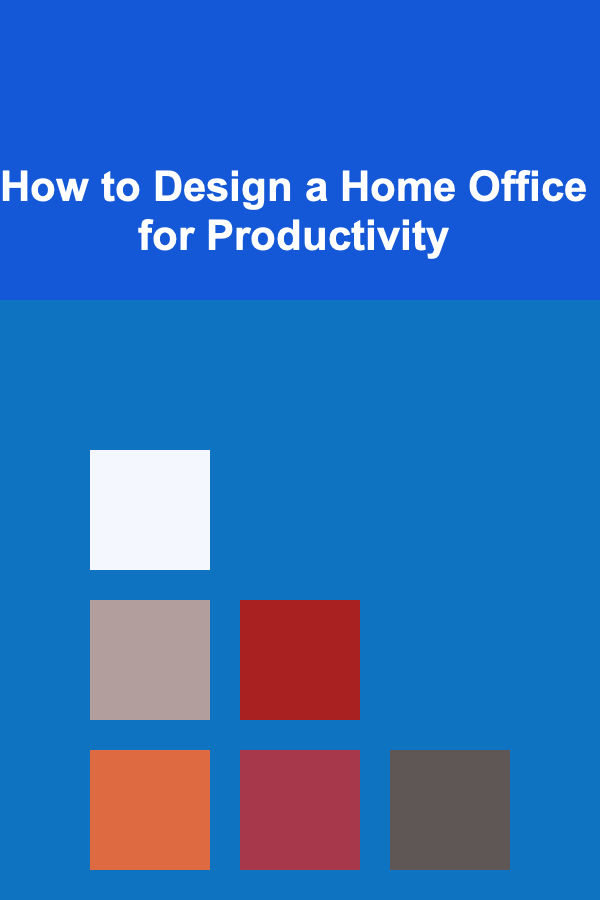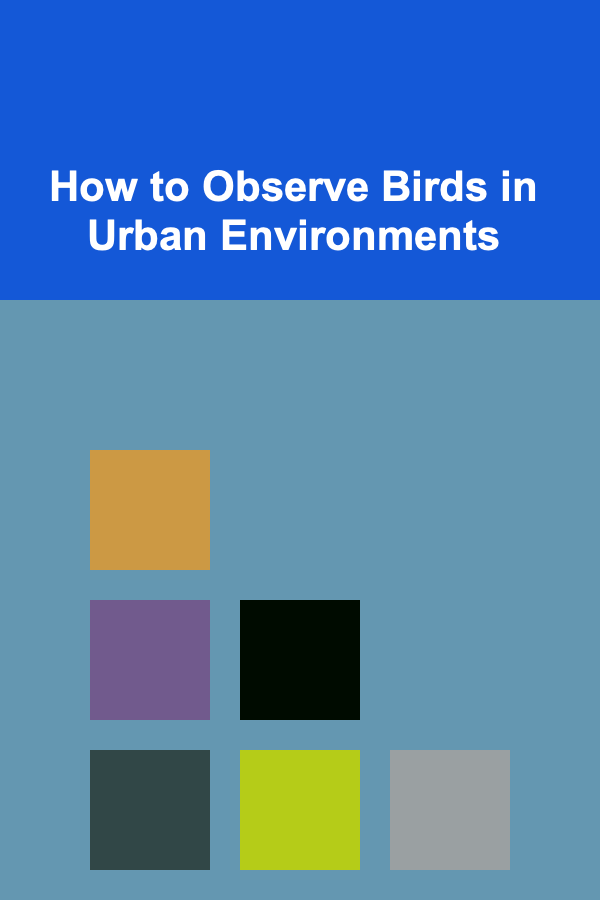
How to Design a Home Office for Productivity
ebook include PDF & Audio bundle (Micro Guide)
$12.99$9.99
Limited Time Offer! Order within the next:

In the modern world, working from home has become a common practice. Whether you're an entrepreneur, a freelancer, or someone working remotely for a corporation, the space where you work plays a pivotal role in determining your productivity. A well-designed home office isn't just about aesthetics; it's about creating an environment that fosters focus, reduces distractions, and makes you feel comfortable and motivated to work.
Designing a home office for maximum productivity involves more than just choosing the right desk and chair. It's about understanding how various design elements---lighting, furniture, layout, and even color schemes---affect your mood, energy, and ability to concentrate. This guide will walk you through the essential considerations and strategies to design a home office that boosts your productivity.
The Importance of an Ergonomic Workspace
The first and most crucial consideration when designing a home office is ergonomics. Your desk, chair, and workspace should support your body's natural posture and reduce strain. Poor ergonomics can lead to discomfort, fatigue, and even long-term health issues, which will certainly affect your productivity.
Ergonomic Furniture
- Chair: Choose a chair that supports your lower back, encourages an upright posture, and allows your feet to rest flat on the floor. Adjustable armrests, lumbar support, and a seat that tilts are important features to look for. A good chair can make a world of difference in preventing back pain and promoting comfort during long working hours.
- Desk: Opt for a desk that is the right height for you. Ideally, your desk should allow you to sit with your elbows at a 90-degree angle when typing. If you prefer standing while working, consider investing in a sit/stand desk that lets you alternate between sitting and standing throughout the day.
Monitor Placement
The placement of your monitor is another important ergonomic consideration. Your monitor should be at eye level, around 20 to 30 inches away from your eyes. This prevents neck strain from looking down or craning your neck upward, and helps reduce eye fatigue from prolonged screen time.
Keyboard and Mouse
Ensure that your keyboard and mouse are positioned to allow your arms to remain relaxed while typing. A wrist rest can help avoid repetitive stress injuries like carpal tunnel syndrome, but it's important to ensure your wrists are in a neutral position to avoid strain.
Lighting: The Key to Focus and Well-Being
Lighting has a significant impact on your mood, energy, and overall productivity. Inadequate lighting can cause eye strain, headaches, and fatigue, which will make it difficult to focus on your tasks.
Natural Light
Whenever possible, position your desk near a window where natural light can pour in. Studies have shown that exposure to natural light increases alertness, improves mood, and enhances cognitive function. Natural light also helps regulate your circadian rhythm, which can promote better sleep and a more energetic day.
Artificial Lighting
If natural light is limited in your space, you'll need to rely on artificial lighting. Overhead lighting should be soft, not harsh, and avoid creating glare on your screen. Task lighting, such as a desk lamp, can help illuminate specific work areas. LED lamps with adjustable brightness and color temperature are an excellent choice, as they mimic natural daylight and are gentle on the eyes.
Avoid Overhead Fluorescent Lights
Fluorescent lighting can cause headaches, eye strain, and a decrease in focus. If your home office has overhead fluorescent lights, consider replacing them with softer, warmer lighting options. Additionally, avoid positioning your desk directly under strong overhead lights, as they can create distracting shadows and glare.
Creating a Distraction-Free Environment
One of the main challenges of working from home is dealing with distractions. Whether it's household chores, children, pets, or social media, distractions can severely impact your productivity. To design a home office that minimizes distractions, consider the following:
Separate Work and Living Spaces
If possible, designate a separate room or area in your home exclusively for work. This physical boundary helps mentally separate work from leisure, making it easier to focus during work hours and relax during personal time. If a separate room is not feasible, create a designated workspace within a larger room, such as a corner or alcove.
Noise Control
If you work in a noisy environment, noise-canceling headphones or white noise machines can be invaluable tools for minimizing distractions. Alternatively, you can use soft textiles---such as curtains, rugs, or upholstered furniture---to absorb sound and create a quieter, more focused environment.
Limit Digital Distractions
Consider using website blockers or productivity apps to limit your access to social media or other distracting sites during work hours. Having a designated time for checking emails or social media can help you resist the temptation to check them constantly throughout the day.
Declutter Your Space
Clutter is a major source of distraction. A cluttered desk can lead to feelings of stress and overwhelm, making it harder to focus. Keep your workspace tidy by organizing your desk and storage areas. Use drawers, shelves, or filing cabinets to store paperwork and office supplies out of sight.
The Role of Color and Aesthetics in Productivity
Color psychology plays a vital role in how we feel and perform in our environments. The right color palette for your home office can enhance focus, creativity, and relaxation, all of which are essential for productivity.
Colors to Promote Focus
- Blue: Blue is known to promote calmness and concentration. It is often used in environments where focus is required, such as in offices and libraries.
- Green: Green is a color that represents balance and harmony. It is calming to the eyes and can help reduce stress, making it ideal for workspaces where you want to remain calm and productive.
- Neutral Colors: Shades of gray, beige, or white can help create a clean and professional environment. These colors are versatile and allow other elements, such as artwork or plants, to stand out.
Colors to Avoid
- Red: While red is stimulating and can increase energy, it is also associated with heightened emotions and stress. Red may be a good choice for a short burst of creative work, but it can be overwhelming when used excessively in a home office.
- Yellow: While yellow is associated with optimism and creativity, it can also lead to frustration and anxiety if overused. It's best to incorporate yellow in small accents rather than large areas.
Personalization and Decor
Incorporate personal items that motivate and inspire you---whether it's artwork, inspirational quotes, or a plant. Personalizing your space makes it feel more welcoming and increases your emotional connection to the workspace. Just be mindful not to over-decorate, as too many distractions can reduce focus.
Functional Layout and Workflow
An efficient layout and workflow are essential to maintaining productivity in a home office. The arrangement of furniture, tools, and storage can influence how easily you can access necessary items, move between tasks, and stay organized.
Desk Placement
Place your desk in a way that allows you to work efficiently. If you need to use a computer, position your monitor so it's directly in front of you, without the need for excessive neck movement. Keep essential tools within arm's reach---such as pens, notebooks, and a phone---to minimize unnecessary movement.
Zones for Different Tasks
If your home office involves multiple tasks (e.g., reading, video calls, brainstorming), consider creating distinct zones within your space. For instance, you could set up a small reading nook with comfortable seating and lighting, while keeping your desk area dedicated to work. A dedicated space for video calls ensures that you maintain a professional appearance during virtual meetings.
Storage and Organization
Keep your home office organized by incorporating enough storage to keep your workspace clear of clutter. Use filing cabinets, bookshelves, or storage bins to store paperwork, office supplies, and other materials. An organized space helps reduce mental clutter, making it easier to focus and stay on top of your tasks.
Adding Comfort and Motivation
While functionality is essential, comfort and motivation are also crucial for maintaining productivity in a home office. A comfortable workspace allows you to work for longer periods without feeling drained or uncomfortable, while motivational elements help keep you inspired and focused.
Comfort
- Comfortable Seating: Choose ergonomic chairs and cushions to ensure comfort during long working hours.
- Temperature Control: Ensure that your workspace has proper ventilation and temperature control. A well-ventilated, comfortably warm or cool space will help you stay focused and productive.
Motivation
- Inspiration Boards: Create a mood board or inspiration board that reflects your goals and aspirations. This could include career goals, images of your dream projects, or quotes that motivate you.
- Greenery: Adding plants to your office can have a calming effect and increase overall well-being. Plants also help purify the air and add an aesthetic touch to your workspace.
Conclusion
Designing a productive home office goes beyond choosing the right furniture and decor. It involves understanding how different elements like ergonomics, lighting, color, layout, and personal comfort can work together to foster a space that supports your focus, creativity, and well-being. By creating an environment that caters to both your physical and mental needs, you can improve your productivity, reduce stress, and achieve better work-life balance. The key is to make the space truly your own---so it motivates and energizes you each day.

Creative Brand Identity: A Comprehensive Guide to Graphic Design for Business Professionals
Read MoreHow to Use Expense Tracking Apps to Simplify Your Process
Read More
How to Use Financial Modeling to Make Money
Read More
How to Prepare Delicious Smoothie Recipes
Read More
How to Observe Birds in Urban Environments
Read More
10 Tips for Animating on a Budget
Read MoreOther Products

Creative Brand Identity: A Comprehensive Guide to Graphic Design for Business Professionals
Read MoreHow to Use Expense Tracking Apps to Simplify Your Process
Read More
How to Use Financial Modeling to Make Money
Read More
How to Prepare Delicious Smoothie Recipes
Read More
How to Observe Birds in Urban Environments
Read More